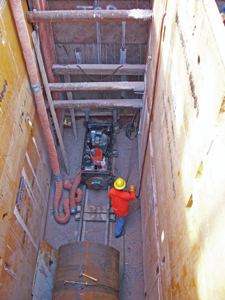Phoenix CityScape Project
 At $900 million, the largest private development project in Phoenix is nearing completion. In retrospect, it’s interesting to look back on the phases that reportedly caused the project team the most trouble.
At $900 million, the largest private development project in Phoenix is nearing completion. In retrospect, it’s interesting to look back on the phases that reportedly caused the project team the most trouble.
At 28 stories, 2.5 million sq ft and covering three lineal blocks, CityScape — an ultra-modern, multi-use facility — is being constructed right in the middle of downtown Phoenix, with about as much ease as inserting a large boat into a small bottle.
In addition to a high-rise office tower, first phase plans also included expansion of an existing five-story underground garage at Central Avenue to accommodate the new facility’s parking needs. Surprisingly, it was reported that this was the most challenging and time consuming part of phase 1 construction. For trenchless construction specialist, Arvid Veidmark III of Specialized Services Co. (SSC), however, this was no surprise at all.
Expansion of the underground facility involved the relocating of an expansive network of existing underground utilities that supported the busy downtown area and included electric, gas, sewer and communications. Like any metropolitan city, tearing up roads, disrupting traffic and construction noise were all major issues. In addition, relocating the utilities required construction under the new light rail tracks, also a major concern.
Four months prior to construction, the construction manager called on Veidmark, who is executive vice president and senior estimator for SSC, to consult on the complex utility issues. Although he admits this project was no easy feat, this was his area of expertise and he was eager and up for the challenge.
For Veidmark and his team, space was the biggest issue. They needed room to maneuver their equipment. Two boring events were planned. The first was a 60-ft bore to install 54-in. steel casing under the new light rail system at Washington and Central Avenues. The original design called for two horizontal auger bores to install 50 conduits (40 to 4 in. and 10 to 5 in.), but after careful investigation and planning, Veidmark suggested one 54-in. hand tunnel.
“Given the size of the area we had to work in, 24 ft by 60 ft for the pit, shoring, crane and other equipment, a hand tunnel was the only option. No other method could be accomplished in a 9-ft by 24-ft pit,” Veidmark said. “This was a very unusual situation. We didn’t have the space for normal separation of utilities so we bundled them in the smallest casing we could.”
According to Veidmark, it took his team about five weeks to complete the bore.
The second bore, under the busy intersection at 1st Street and Washington Avenue, called for installation of 75 ft of 30-in. steel casing for APS electrical conduits. Pipe ramming was selected because it could be performed in a shallow, narrow pit. Although it would cause some noise and traffic issues, it could be completed in the quickest amount of time and cause the least amount of disruption.
“Just as the first complaint came in about the noise, the bore was finished — about eight hours total ramming time,” Veidmark said. This was the smallest pit SSC had ever worked in for a pipe ramming application (33 ft by 12 ft by 16 ft).
According to Veidmark, although this was an atypical project, it was not the utility relocating that caused the setbacks, but the attention paid to its importance in the design phase. He says there’s a good reason why most federal agencies now mandate the use of subsurface utility engineering. “This project was like a puzzle,” Veidmark said. “The various phases were out of sequence because the unexpected conflicts caused delays while the team waited for redesign and approvals.”
Veidmark admitted that experience has taught him the true benefits of subsurface utility engineering and he is now a strong advocate. He teaches about subsurface utility engineering and other topics in his monthly trenchless technology classes in Phoenix. While he believes that more attention to underground utilities would have prevented some of the resequencing delays that occurred, the project team was smart to bring him in when they did.
Kit Anderson is marketing manager for Specialized Services Co., which is headquartered in Phoenix.
![]()
